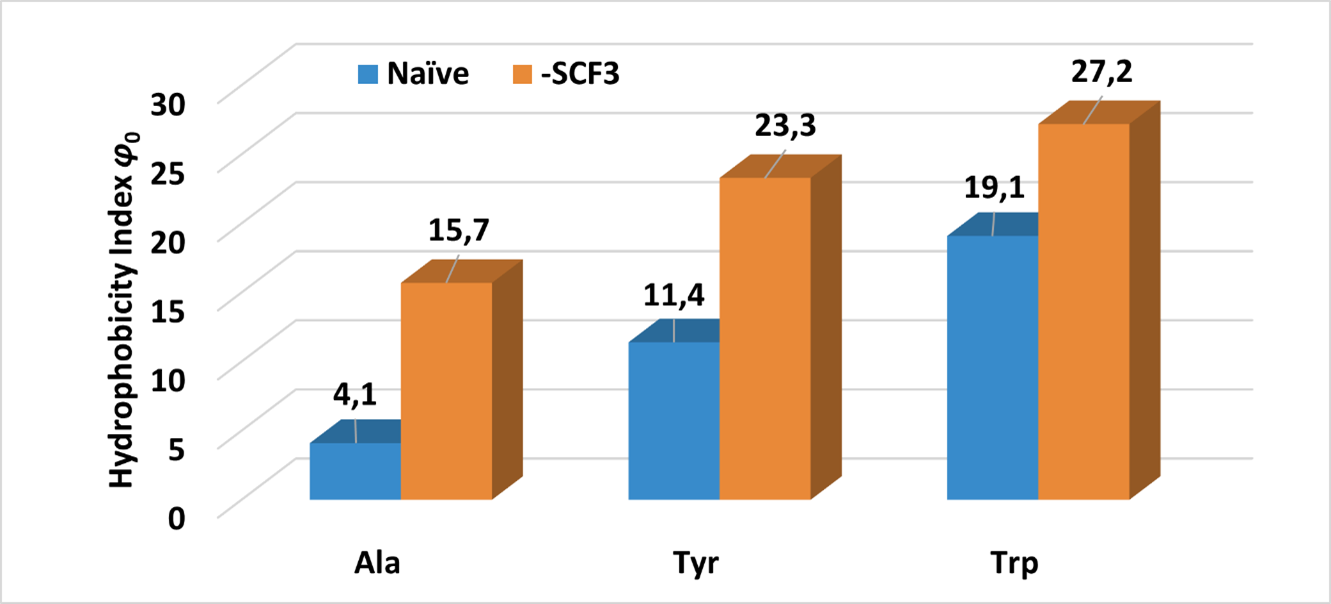Welcome to Iris Biotech
For better service please confirm your country and language we detected.

For better service please confirm your country and language we detected.

Thank you very much for your interest in our products. All prices listed on our website are ex-works, Germany, and may attract customs duties when imported.
You may/will be contacted by the shipping company for additional documentation that may be required by the US Customs for clearance.
We offer you the convenience of buying through a local partner, Peptide Solutions LLC who can import the shipment as well as prepay the customs duties and brokerage on your behalf and provide the convenience of a domestic sale.
Continue to Iris Biotech GmbHSend request to US distributorPublished on 23/01/2024

Fluorine is the element with the highest electronegativity. Adding fluorine residues decreases the electron density in the adjacent system and increases the polarity of the modified molecule. Thus, the selective fluorination of amino acids at specific positions is a popular strategy to modulate the properties of the resulting peptide, e.g., increased metabolic stability and enhanced lipophilicity.
Especially the trifluoromethylthio group is known for its high lipophilicity (Hansch-Leo parameter: π = 1.44), which is even higher than that of the trifluoromethyl group (π = 0.88), and a strong electron-withdrawing effect (Hammett constants: σm = 0.40, σp = 0.50).
Besides, addition of a -SCF3 group to an amino acid increases the local hydrophobicity of the synthetic peptide compared to the unmodified peptide. The diagram below shows the hydrophobicity of H2N-Ala-X-Leu-OH tripeptides, where X stands for the amino acids Ala, Tyr, and Trp (without modification: blue bar) and their trifluoromethylthiolated analogs (orange bar). See related products at the end of this blog post for the available trifluoromethylthiolated Ala, Tyr, and Trp building blocks.

Hydrophobicity of H2N-A-X-L-OH tripeptides. X = Ala, Tyr, and Trp. Blue bar: unmodified X. Orange bar: trifluoromethylthiolated X. φ0 is calculated from the retention time in RP-HPLC.
Thus, the incorporation of a trifluoromethylthio group may lead to a higher membrane permeability (a property which is frequently desired in drug development), as well as to an increased stability of peptides against proteolytic degradation and against oxidation in physiological environments. One further benefit of such an improved pharmacological profile is that the required dosage of a drug may be reduced.
Besides, the introduction of fluorine into peptides and other molecules renders them suitable as probes for protein-protein interactions, which can be measured by 19F NMR.
→ Interested in all our fluorinated building blocks? Download our flyer!
→ Looking for other SCF3 derivatives? Get in contact for a custom synthesis!
References:
Trifluoromethylthiolation of Tryptophan and Tyrosine Derivatives: A Tool for Enhancing the Local Hydrophobicity of Peptides; J. Gregorc, N. Lensen, G. Chaume, J. Iskra, T. Brigaud; J Org Chem 2023; 88: 13169-13177. https://doi.org/10.1021/acs.joc.3c01373
Probing the Outstanding Local Hydrophobicity Increases in Peptide Sequences Induced by Incorporation of Trifluoromethylated Amino Acids; C. Gadais , E. Devillers, V. Gasparik, E. Chelain, J. Pytkowicz, T. Brigaud; Chembiochem 2018; 19: 1026-1030. https://doi.org/10.1002/cbic.201800088
Trifluoromethyl ethers and -thioethers as tools for medicinal chemistry and drug discovery; G. Landelle, A. Panossian, F. Leroux; Curr Top Med Chem 2014; 14: 941-951. https://doi.org/10.2174/1568026614666140202210016
Selective Fluorination in Drug Design and Development: An Overview of Biochemical Rationales; K. Kirk, Curr Top Med Chem 2006; 6: 1447-1456. https://doi.org/10.2174/156802606777951073
Fluorine in Peptide Design and Protein Engineering; C. Jäckel, B. Koksch; Eur J Org Chem 2005; 21: 4483-4503. https://doi.org/10.1002/ejoc.200500205
Deciphering the Fluorine Code—The Many Hats Fluorine Wears in a Protein Environment; A. Berger, J. Völler, N. Budisa, B. Koksch; Acc Chem Res 2017; 50: 2093-2103. https://doi.org/10.1021/acs.accounts.7b00226
NMR-Solution Structures and Affinities for the Human Somatostatin G-Protein-Coupled Receptors hsst1-5 of CF3 Derivatives of Sandostatin® (Octreotide); D. Seebach, H. Widmer, S. Capone, R. Ernst, T. Bremi, I. Kieltsch, A. Togni, D. Monna, D. Langenegger and D. Hoyer; Helv Chim Acta 2009; 92: 2577-2586. https://doi.org/10.1002/hlca.200900279